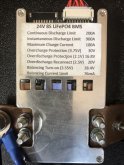I’ve built an 8S 90Ah LiFePO4 battery using a bare-bones China-sourced BMS probably similar to the Daly:

I’ve started running some charge/discharge cycles on my new battery and realize I really don’t understand how balancing works.
During the charge cycle, does ‘Balancing Turn-On 3.55V’ mean that when individual cells reach 3.55V, 76mA are pulled out of them (and dumped to ground) in an effort to ‘hold them back’ / ‘slow them down’ until the other cells catch up?
Is balancing typically active whenever cells are above this ‘Balancing Turn-On’ threshold or only when the battery is actively charging?
I’ve charged my battery to 28.6V (average of 3.575V/cell) and left the charger connected overnight (with no apparent charge flowing based on the color of the indicator light), but the next morning, the ‘high’ cell was just as high as before.
Would like to understand how the balance function on these bare-bones BMSes as well as higher-end BMSes works so I can decide what BMS capability I want for the new 280Ah 8S battery I am planning...
From a quick check, the Chargery BMS has a much more significant balance current of > 1A. Is that balancing active throughout the discharge cycle or only during charging and only at the high-end like my bare-bones BMS?

I’ve started running some charge/discharge cycles on my new battery and realize I really don’t understand how balancing works.
During the charge cycle, does ‘Balancing Turn-On 3.55V’ mean that when individual cells reach 3.55V, 76mA are pulled out of them (and dumped to ground) in an effort to ‘hold them back’ / ‘slow them down’ until the other cells catch up?
Is balancing typically active whenever cells are above this ‘Balancing Turn-On’ threshold or only when the battery is actively charging?
I’ve charged my battery to 28.6V (average of 3.575V/cell) and left the charger connected overnight (with no apparent charge flowing based on the color of the indicator light), but the next morning, the ‘high’ cell was just as high as before.
Would like to understand how the balance function on these bare-bones BMSes as well as higher-end BMSes works so I can decide what BMS capability I want for the new 280Ah 8S battery I am planning...
From a quick check, the Chargery BMS has a much more significant balance current of > 1A. Is that balancing active throughout the discharge cycle or only during charging and only at the high-end like my bare-bones BMS?


